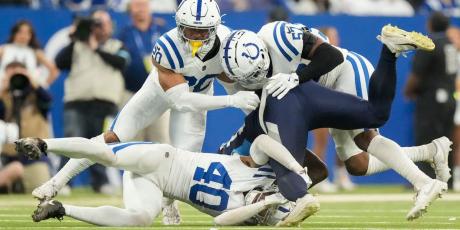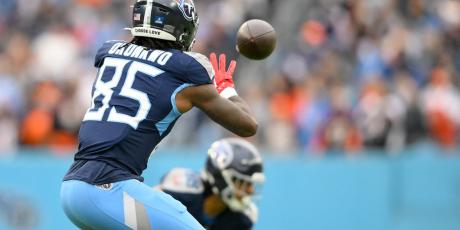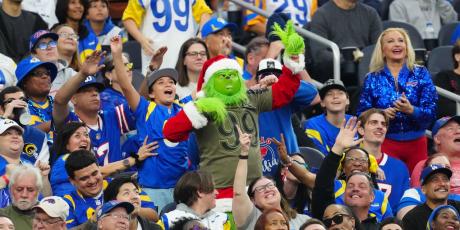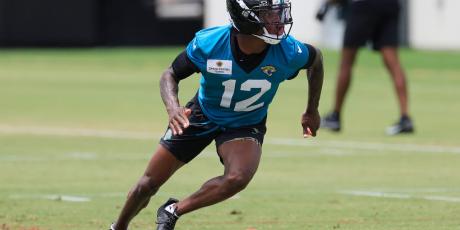Streaming Tight Ends Primer and 8 Upside Targets

Tight end by waiver wire (TEBWW), or tight end streaming, is not only a viable approach to filling out your fantasy football roster, it's my preferred method of drafting in most leagues. Outside of Rob Gronkowski, foregoing the opportunity to draft running backs and wide receivers in the early and middle rounds is usually a poor investment strategy. The issue is one of supply and demand.
Most fantasy football leagues start two running backs, two to three wide receivers and a flex, which is usually filled out by a running back or wide receiver. With leagues starting 24 to 36 backs and possibly 40+ receivers each week, drafting the top talent and adequate depth at these positions is paramount. Even then, owners still battle it out on the waiver wire, struggling to fill out the RB and WR slots, especially during the thin bye weeks.
Compared to running backs and wide receivers, the demand for tight ends is relatively low. Except for the deepest leagues, there is usually a surplus of serviceable tight end options. Because I know I have the waiver wire to fall back on, I'm content letting my league mates spend valuable draft capital on the "onesie" positions, while I acquire depth at the positions that are always in demand.
Though I'm comfortable streaming the tight end position, the goal of the late round tight end approach to drafting is to nail down an every week starter at virtually no cost. This method means targeting upside with a couple of picks in the double digit rounds.
Targeting Tight End Upside
Before putting together a list of upside targets, we should first define what we are looking for. Last offseason, Chris Raybon explained why we should target targets when choosing our tight ends. Targets, especially red zone targets, have the strongest correlation with fantasy success when it comes to the tight end position.
What does a starting fantasy tight end look like in terms of targets? In 2014, the average output for a tight end that finished a week as the PPR TE6 or better was 6.1 catches on 8.1 targets for 20.2 fantasy points. Tight ends that finished in the TE7-TE12 range averaged 4.4 receptions on 6.2 targets for 12.2 PPR FPs per week. By exploring team passing volume and ball distribution to the tight ends, we can target tight ends that have a reasonable shot at seeing six to eight targets per game, especially on teams where the offense shouldn't change much from last season.
| Team | Pass Attempts | TE Targets | TE % of Tgts |
|---|---|---|---|
| NO | 659 | 176 | 26.71% |
| NE | 610 | 171 | 28.03% |
| IND | 660 | 164 | 24.85% |
| CHI | 609 | 150 | 24.63% |
| CAR | 545 | 149 | 27.34% |
| STL | 514 | 146 | 28.40% |
| PHI | 623 | 141 | 22.63% |
| WAS | 546 | 132 | 24.18% |
| KC | 491 | 131 | 26.68% |
| TEN | 513 | 125 | 24.37% |
| SD | 573 | 125 | 21.82% |
| MIA | 594 | 124 | 20.88% |
| NYG | 606 | 119 | 19.64% |
| BAL | 555 | 117 | 21.08% |
| DAL | 476 | 109 | 22.90% |
| NYJ | 496 | 107 | 21.57% |
| CIN | 502 | 104 | 20.72% |
| OAK | 628 | 104 | 16.56% |
| CLE | 503 | 100 | 19.88% |
| BUF | 578 | 98 | 16.96% |
| MIN | 517 | 97 | 18.76% |
| PIT | 608 | 97 | 15.95% |
| DEN | 607 | 96 | 15.82% |
| ARI | 566 | 86 | 15.19% |
| SEA | 453 | 83 | 18.32% |
| TB | 530 | 82 | 15.47% |
| GB | 536 | 80 | 14.93% |
| DET | 602 | 79 | 13.12% |
| SF | 486 | 74 | 15.23% |
| JAX | 553 | 71 | 12.84% |
| ATL | 632 | 55 | 8.70% |
| HOU | 483 | 49 | 10.14% |
| Team | RZ Pass Attempts | TE RZ Targets | TE % of RZ Tgts |
|---|---|---|---|
| NO | 81 | 32 | 39.51% |
| IND | 90 | 30 | 33.33% |
| NYG | 104 | 28 | 26.92% |
| NE | 80 | 25 | 31.25% |
| MIA | 93 | 24 | 25.81% |
| CAR | 58 | 24 | 41.38% |
| DEN | 110 | 23 | 20.91% |
| GB | 104 | 23 | 22.12% |
| PHI | 82 | 23 | 28.05% |
| SD | 73 | 23 | 31.51% |
| BAL | 82 | 22 | 26.83% |
| CHI | 82 | 22 | 26.83% |
| NYJ | 72 | 21 | 29.17% |
| STL | 51 | 19 | 37.25% |
| PIT | 98 | 18 | 18.37% |
| KC | 68 | 18 | 26.47% |
| WAS | 64 | 17 | 26.56% |
| BUF | 70 | 16 | 22.86% |
| DAL | 58 | 16 | 27.59% |
| TEN | 56 | 16 | 28.57% |
| DET | 80 | 14 | 17.50% |
| SEA | 57 | 14 | 24.56% |
| CIN | 54 | 14 | 25.93% |
| ARI | 62 | 13 | 20.97% |
| TB | 54 | 10 | 18.52% |
| OAK | 49 | 9 | 18.37% |
| MIN | 42 | 9 | 21.43% |
| HOU | 67 | 8 | 11.94% |
| ATL | 65 | 7 | 10.77% |
| CLE | 42 | 7 | 16.67% |
| JAX | 46 | 6 | 13.04% |
| SF | 48 | 3 | 6.25% |
Indianapolis Colts
Indianapolis is the Mecca for tight end opportunity. In 2014, the Colts ranked first in passing attempts, third in targets to tight ends, and sixth in percent of team targets to tight ends. Their tendencies didn't change in the red zone, either, with the sixth most passing attempts inside their opponents 20, the second most targets to tight ends in the red zone, and the fourth highest percentage of red zone targets to tight ends.
We shouldn't expect much of a difference this year. Andre Johnson is taking over for Reggie Wayne, but Johnson has historically been one of the least efficient touchdown scorers among wide receivers. Frank Gore is an upgrade in the backfield, but Indi already used their running backs as much as any team in the red zone last season and still managed a high volume of tight end looks.
Unfortunately for fantasy owners, the Colts split their tight end targets almost evenly between Dwayne Allen and Coby Fleener. Regardless, tight end is an affordable way to get a piece of this prolific passing attack. Dwayne Allen has shown an inability to stay healthy, and though Allen and Fleener both posted six top-12 PPR weeks last season, five of those games were top-6 weeks for Fleener, while Allen posted just two weeks as the TE6 or better.
San Diego Chargers
With Antonio Gates suspended for the first four games of the season, both Gates and Ladarius Green can be scooped up for a reasonable price. The Chargers were tied for the 10th most passing attempts to tight ends, tied for the seventh most red zone targets to tight ends, and had the 5th highest percentage of red zone targets to tight ends in 2014. Philip Rivers was also one of the most efficient touchdown passers in 2014, scoring on 5.4% of his attempts, the seventh best touchdown rate in the league.
When healthy, Danny Woodhead has been a major presence in the red zone for San Diego, especially in the passing game. Stevie Johnson could also siphon off some red zone targets, but as long as the price for Green and Gates remains steady they are worth the risk in this offense. Ideally, Green remains the cheaper option and shows enough in the first four weeks of the season to become an integral part of San Diego's passing attack.
New York Giants
The Giants were one of 11 teams to throw the ball over 600 times last season, and a whopping 104 of those passes came inside the red zone, the second highest total in the league. 28 of those red zone targets went to tight ends, a total bested only by Indianapolis and New Orleans.
Larry Donnell saw his snaps decrease down the stretch in 2014, due to blocking issues, but if he has shored up that issue this offseason he can be one of the highest targeted tight ends in the league, especially with Odell Beckham likely commanding extra defensive attention.
New Orleans Saints
New Orleans tight end numbers jump off the page, but that is almost exclusively because of Jimmy Graham. While the Saints bolstered their backfield with the addition of C.J. Spiller, they did nothing to fill the target void left by Graham's departure.
Marques Colston is on the wrong side of 30 and Brandin Cooks is too small to be a dominant red zone force, which means Josh Hill could be the go to guy when the Saints get near the goal line. Talk of Ben Watson playing ahead of Hill should keep Hill's price down, which is a good thing for drafters seeking late tight end upside.
Miami Dolphins
Although Miami finished 2014 in the middle of the pack in overall passing attempts, they ranked fifth in both red zone attempts and red zone targets to tight ends. They lost their most efficient red zone pass catcher in Mike Wallace, and replaced him with a deep threat and a rookie. Meanwhile, the Dolphins upgraded from Charles Clay to Jordan Cameron at tight end. When healthy, Cameron has shown that he is capable of top five numbers.
Though I don't generally advocate a mid-round tight end strategy, if a value does present itself, I want that player to have top three upside. If he is able to stay on the field, Jordan Cameron is one of the few players in the conversation to overtake Jimmy Graham as the number two fantasy tight end in 2015.
St. Louis Rams
In terms of overall passing volume, the Rams were near the bottom of the league in 2014, but their percentage of targets to tight ends is worth noting. No team targeted the position on a higher percentage of throws than St. Louis, and only two teams threw to the tight end in the red zone at a higher rate.
Jared Cook's splits were virtually identical in games Brian Quick played compared to when Quick was out, so that shouldn't be a major concern, and Nick Foles is a clear upgrade at quarterback over Shaun Hill and Austin Davis. Jeff Fisher is going to continue to favor the running game, but if Foles and Quick can spark this offense, Cook could be a major beneficiary and he's virtually free.
Streaming As A Last Resort
The bottom line when it comes to drafting tight ends is that we want to maximize value. Wherever we choose to draft our tight ends, the position is inherently the most volatile in fantasy football because of tight ends' relatively low usage. This volatility leads to major inconsistency at the position.
In 2014, 57 different tight ends posted top 12 PPR weeks. Of those 57 players, only 14 had 6 or more weeks in the top 12, and just 8 tight ends finished 8 or more weeks as the TE12 or better. While we hope that the tight end we lock up on draft day turns out to be an every week plug and play option, the odds are against it.
If and when owners are forced to opt for TEBWW, 4for4 provides one of the best streaming tools in the industry with the Schedule Adjusted Fantasy Points Allowed (aFPA) metric. I will be using this metric in 2015 as the primary tool to guide me through my weekly TEBWW advice column. Even in one of the most unpredictable tight end seasons in recent history last season, aFPA helped build an optimal waiver wire tight end that averaged 13.5 PPR FP/G, a total that would have finished 7th among tight ends last season.






















